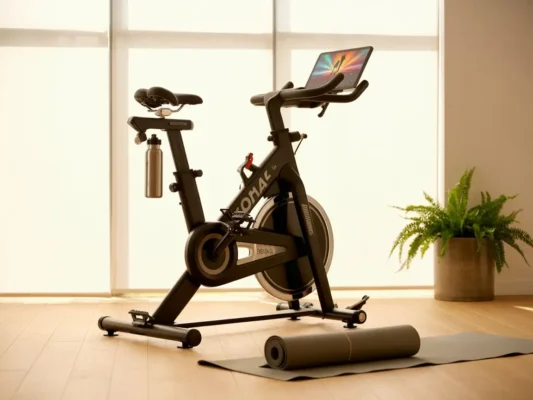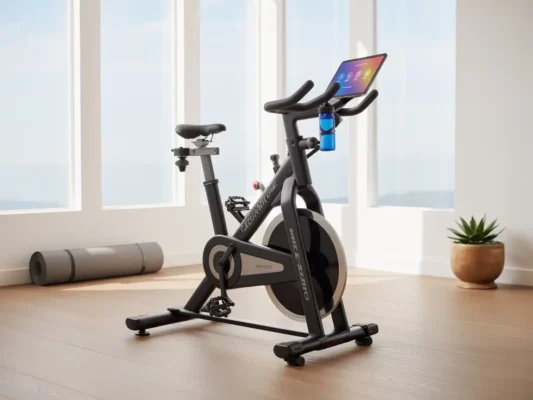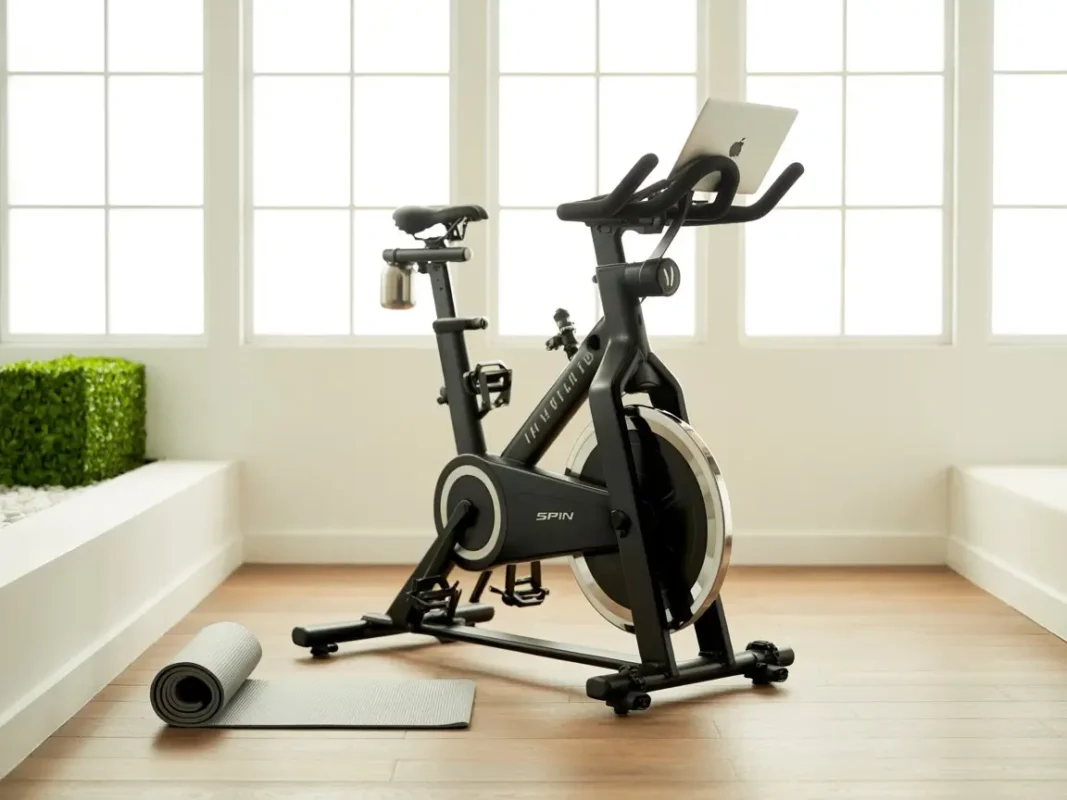Indoor Exercise Bike: Your Complete Guide to Choosing the Perfect Home Cardio Machine
Building your home gym starts with the right cardio equipment, but the choice between an indoor exercise bike, recumbent model, or upright design is tougher than it looks. You need a bike that matches your fitness goals, fits your space, and doesn't break your budget. The right indoor exercise bike can transform your living room into a personal training studio, but only if you know what to look for.
This guide breaks down everything you need to know. You'll learn which bike type suits your workout style, how to spot quality features, and which models deliver real value. No fluff, just straight answers to help you make the right choice.
What's the Difference Between Indoor Cycling Bikes and Regular Exercise Bikes?
Indoor cycling bikes (also called spin bikes) feature a heavy flywheel and aggressive riding position that mimics road cycling. Regular exercise bikes include upright and recumbent models with lighter flywheels and more comfortable seating positions.
The main difference lies in workout intensity. Spin bikes are designed for high-intensity interval training and studio-style classes with standing sprints and resistance climbs. Regular exercise bikes work better for steady-state cardio, rehabilitation, or low-impact workouts where comfort matters more than performance.
Key Features of Indoor Cycling Bikes
Indoor cycling bikes use friction or magnetic resistance with flywheels weighing 30-50 pounds. This heavy flywheel creates smooth momentum that feels similar to outdoor riding. You sit forward with your hands on drop-style handlebars, which engages your core throughout the workout.
Best for: HIIT workouts, weight loss programs, virtual cycling classes, and anyone who wants an aggressive cardio challenge.
Top picks: The YOSUDA Indoor Cycling Bike delivers solid performance at budget prices, while the MERACH Exercise Bike adds app connectivity for tech-savvy riders. POOBOO Exercise Bike offers premium build quality for serious training.
Understanding Recumbent Exercise Bikes
Recumbent bikes position you in a reclined seat with back support and pedals in front of you. This design removes pressure from your lower back and joints, making them ideal for rehabilitation or extended cardio sessions.
Your weight distributes across a larger seat surface, which means you can pedal for longer without discomfort. Most models include adjustable lumbar support and easy-access entry that doesn't require lifting your leg over a frame.
Best for: Seniors, rehabilitation programs, people with joint issues, anyone recovering from injury, or riders who prioritize comfort during longer sessions.
Top pick: The JEEKEE Recumbent Exercise Bike combines ergonomic design with quiet magnetic resistance, perfect for extended workout sessions.
What Makes Upright Exercise Bikes Different?
Upright bikes give you the traditional bicycle feel in a compact package. You sit upright with the pedals directly below, which takes up less floor space than recumbent models and costs less than most spin bikes.
These bikes work well for general fitness because they engage more muscle groups than recumbent models without the intensity demands of spin bikes. The upright position strengthens your core while keeping the workout accessible for most fitness levels.
Best for: Small apartments, general fitness routines, moderate cardio sessions, and anyone who wants versatility without committing to high-intensity training.
Top pick: The WENOKER Stationary Bike packs smart features into a space-saving design that fits most budgets.
How Do I Choose the Right Indoor Exercise Bike for Weight Loss?

You need a bike with adjustable resistance, a comfortable seat, and features that keep you motivated for 30-45 minute sessions. Weight loss happens when you burn calories consistently, which means your bike must be enjoyable enough to use regularly.
Look for bikes with at least 8 resistance levels and a flywheel heavy enough (20+ pounds) to maintain smooth momentum during interval training. A built-in monitor that tracks calories, distance, and time helps you measure progress and stay accountable.
Critical Buying Considerations
Resistance Type: Magnetic resistance runs quieter and requires less maintenance than friction pads. You adjust intensity with a knob or digital controls, and the resistance stays consistent without wearing down over time. Friction resistance costs less upfront but needs pad replacements every 6-12 months.
Flywheel Weight: Heavier flywheels (35+ pounds) create smoother rides with better momentum. Light flywheels feel jerky during high-intensity intervals and make it harder to maintain consistent pedaling speed. Budget bikes often cut corners here, so check the weight before buying.
Tech Integration: Smart bikes connect to apps like Zwift, Peloton Digital, or Kinomap for virtual rides and structured workouts. This matters if you get bored easily or need external motivation. Basic bikes save money but require self-directed training.
Adjustability Matters More Than You Think
Your bike must fit your body or you'll quit using it. Seat height should allow a slight knee bend at the bottom of each pedal stroke. Handlebar reach needs adjustment so you're not straining your back or shoulders.
Check the user weight capacity too. Most budget bikes max out at 220-280 pounds, while commercial-grade models support 300+ pounds. Going over capacity voids warranties and creates safety risks.
Which Exercise Bike Is Best for Small Apartments?

Upright bikes and folding models take up the least space, typically requiring a 2×4 foot footprint. Spin bikes need slightly more room (3×4 feet) for safe mounting and dismounting, while recumbent bikes demand the most space (4×5 feet) due to their extended frame design.
Measure your available space before shopping, then add two feet on all sides for comfortable access. You also need clearance for any moving parts like pedals or adjustable seats.
Space-Saving Features
Look for transport wheels on the front stabilizer for easy moving between rooms. Some upright bikes fold vertically for closet storage, though folding mechanisms add potential failure points. Fixed-frame bikes last longer but require permanent floor space.
Wall-mounted tablet holders and bottle cage placements keep accessories organized without adding bulk. Avoid bikes with wide handlebars or extended seat posts if you're tight on space.
Pro Tip: The WENOKER Stationary Bike combines compact dimensions with full features, making it ideal for apartment living.
What Features Actually Matter in an Indoor Exercise Bike?
Silent operation, adjustable resistance, and a comfortable seat determine whether you'll actually use your bike. Everything else is secondary. Fancy consoles and built-in speakers add cost without improving your workout results.
Focus your budget on mechanical quality first. A bike with smooth, quiet resistance and comfortable ergonomics beats a cheaper model with fancy tech that breaks in six months.
Must-Have Features
Magnetic Resistance System: Provides quiet, smooth resistance adjustments without friction pad wear. This matters if you live in an apartment or work out early in the morning.
Adjustable Seat (Vertical + Horizontal): Proper bike fit prevents knee pain and back strain. Four-way adjustability (up/down and forward/back) accommodates different body types better than two-way systems.
Sturdy Frame: Steel frames with reinforced joints last longer and wobble less during intense intervals. Check for a solid, one-piece crank arm rather than cheap plastic connectors.
Basic Monitor: Tracking time, distance, speed, and calories burned helps maintain motivation. You don't need Bluetooth or app connectivity unless you specifically want virtual classes.
Nice-to-Have Upgrades
Bluetooth connectivity lets you stream heart rate data to fitness apps. Built-in device holders keep your tablet stable during virtual rides. Dual water bottle holders, accessory trays, and built-in speakers improve convenience but don't affect workout quality.
Some smart bikes offer automatic resistance control that syncs with virtual courses. This premium feature costs $300-500 extra but creates immersive training experiences.
The Price vs Value Breakdown
Budget indoor exercise bikes ($200-$300) provide basic cardio workouts but sacrifice durability and comfort. Mid-range bikes ($300-$600) offer better build quality, quieter operation, and improved adjustability. Premium models ($600+) deliver commercial-grade components and advanced tech integration.
Most people get the best value in the $300-$500 range. You gain significant quality improvements over budget models without paying for features you might not use.
Budget Category (Under $300)
YOSUDA Indoor Cycling Bike – Solid spin bike with 35-pound flywheel and adjustable resistance. Perfect entry point for indoor cycling without major compromises.
JEEKEE Recumbent Exercise Bike – Eight resistance levels with comfortable padded seat. Great value for low-impact workouts and rehabilitation needs.
Mid-Range Options ($300-$600)
MERACH Exercise Bike – App-connected smart bike with automatic resistance control. Ideal for tech enthusiasts who want structured training programs.
POOBOO Exercise Bike – Heavy-duty spin bike with commercial-grade components. Built for daily high-intensity training without mechanical failures.
What You're Actually Paying For
Cheaper bikes use lighter flywheels, lower-grade steel, and basic monitors. They work fine for occasional use but wear out faster with daily workouts. Mid-range bikes invest in better bearings, heavier flywheels, and more adjustment points.
Premium bikes add app subscriptions, larger screens, and automatic resistance features. These matter if you need external motivation, but they don't make the actual workout more effective.
Top 5 Indoor Exercise Bikes
YOSUDA Indoor Cycling Bike – Heavy flywheel creates smooth momentum perfect for spin classes. Adjustable seat and handlebars fit most body types. Some users report squeaking after 6 months of heavy use.
JEEKEE Recumbent Exercise Bike – Supportive backrest reduces strain during longer sessions. Eight resistance levels handle beginner to intermediate workouts. Assembly takes 45-60 minutes but instructions are clear.
WENOKER Stationary Bike – Compact footprint with 16 digital resistance levels. Bluetooth monitor tracks all essential metrics. Seat padding could be thicker for extended rides.
MERACH Exercise Bike – App connectivity provides structured workouts and virtual rides. Magnetic resistance stays whisper-quiet during early morning sessions. Premium price justified by smart features.
POOBOO Exercise Bike – Built like a commercial gym bike with reinforced frame. Handles aggressive sprints and standing climbs without wobbling. Heavy unit (100+ lbs) requires dedicated space.
Matching Your Fitness Goals to the Right Bike
Your workout style determines which bike type serves you best. Don't buy based on price alone or you'll end up with equipment that doesn't match your training needs.
For Weight Loss & HIIT Training
You need a spin bike with heavy flywheel and friction or magnetic resistance. The aggressive riding position engages your core while the resistance system allows quick intensity changes during intervals.
Programs like Tabata (20 seconds max effort, 10 seconds rest) work perfectly on spin bikes. The heavy flywheel maintains momentum during rest periods, making transitions smoother than upright bikes allow.
Recommended: YOSUDA Indoor Cycling Bike for budget-conscious buyers, POOBOO Exercise Bike for serious training.
For Rehabilitation & Joint Health
Recumbent bikes remove stress from your lower back, hips, and knees. The reclined position with back support lets you focus on rebuilding strength without pain.
Physical therapists often recommend recumbent bikes for post-surgery recovery because you can start with very low resistance and progress gradually. The stable, supported position prevents form breakdown when your muscles fatigue.
Recommended: JEEKEE Recumbent Exercise Bike offers the comfort and adjustment range needed for recovery work.
For General Fitness in Compact Spaces
Upright bikes balance space efficiency with workout effectiveness. You get enough resistance for cardio conditioning without committing to high-intensity spin training.
These bikes fit well into multipurpose spaces because they move easily and don't dominate the room. You can watch TV, read, or take work calls while maintaining moderate-intensity cardio.
Recommended: WENOKER Stationary Bike maximizes features within a small footprint.
For Tech-Integrated Training
Smart bikes with app connectivity provide structured workouts, virtual competitions, and automatic resistance adjustments. This matters if you need external motivation or get bored with self-directed training.
Apps like Zwift and Kinomap turn your indoor bike into a virtual racing platform. You can join group rides, compete in challenges, and explore digital routes from around the world.
Recommended: MERACH Exercise Bike delivers full smart bike features without Peloton pricing.
Pro Tips: Assembly, Maintenance & Safety
Most exercise bikes arrive 80% assembled with remaining work taking 30-60 minutes. You'll need basic tools (usually included) and enough space to lay out parts.
Assembly Expectations
Set aside 90 minutes for your first bike assembly. Read all instructions before starting, then organize hardware by step. Most problems come from skipping ahead or mixing up similar-looking bolts.
Recruit a helper for attaching the frame to the base. This step involves lifting 40-60 pounds into position while aligning bolt holes. Trying this solo risks dropping the frame or stripping threads.
Important: Double-check all bolts after 1-2 rides. Vibration during shipping can loosen some connections that tighten properly during assembly.
Monthly Maintenance Checklist
- Check all bolts and connections – Tighten any that have loosened from regular use
- Wipe down frame and seat – Remove sweat residue that can corrode metal over time
- Inspect friction pads (if applicable) – Replace when worn below 1/4 inch thickness
- Lubricate moving parts – Apply bike chain lubricant to exposed mechanisms
- Test resistance adjustment – Make sure it operates smoothly through full range
- Vacuum around base – Remove dust and debris that can affect moving parts
Proper Bike Fit Guide
Adjust seat height so your knee bends 25-30 degrees at the bottom of each pedal stroke. Too high causes hip rocking, while too low strains your knees.
Set handlebar height level with or slightly above seat height for comfort. Lower handlebars create aggressive positions for interval training but cause shoulder strain during longer rides.
Position the seat forward/back so your knee aligns over the pedal spindle when cranks are horizontal. This neutral position distributes power efficiently without stressing your joints.
Frequently Asked Questions
How much space do I need for an indoor exercise bike?
A: Upright bikes need approximately 2×4 feet of floor space. Spin bikes require 3×4 feet, while recumbent models need 4×5 feet. Add 2 feet of clearance on all sides for safe mounting and dismounting.
Are expensive exercise bikes worth the cost?
A: Mid-range bikes ($300-$500) offer the best value with quality components and decent warranties. Premium bikes add smart features and better warranties but don't deliver significantly better workouts. Budget bikes work for occasional use but wear out faster.
What's better for weight loss – spin bike or recumbent bike?
A: Spin bikes burn more calories per session because they enable higher-intensity workouts. However, the best bike for weight loss is the one you'll actually use consistently. If joint pain keeps you off a spin bike, a comfortable recumbent bike that you use daily beats a spin bike collecting dust.
How long do home exercise bikes last?
A: Quality bikes with regular maintenance last 5-10 years. Budget models typically last 2-3 years with moderate use. Friction resistance bikes need pad replacements every 6-12 months, while magnetic resistance bikes run maintenance-free for years.
Can I use an indoor exercise bike for Peloton or Zwift classes?
A: Yes, but you'll need a bike with Bluetooth connectivity or a separate cadence sensor. Apps like Peloton Digital, Zwift, and Kinomap work with most exercise bikes, though you won't get automatic resistance changes without a smart bike.
What resistance type is quietest?
A: Magnetic resistance systems run nearly silent, making them ideal for apartments or early morning workouts. Friction resistance creates some noise from the brake pad contact but costs less initially.
Do I need a heart rate monitor on my exercise bike?
A: Heart rate tracking helps optimize cardio training and track progress, but it's not essential. Many riders use chest straps or smartwatches that provide more accurate readings than handlebar sensors.
Ready to Transform Your Home Workouts?
The right indoor exercise bike changes everything about your fitness routine. You eliminate gym commutes, workout on your schedule, and build consistency that drives real results.
Start by defining your primary goal – weight loss, rehabilitation, general fitness, or intense training. Match that goal to the bike type that supports it, then focus your budget on mechanical quality over fancy features.
Choose a spin bike like the YOSUDA or POOBOO for aggressive workouts. Pick the JEEKEE Recumbent for comfort-focused training. Select the WENOKER for space-saving versatility. Or invest in the MERACH for tech-integrated smart training.
Whatever you choose, the hardest part is starting. Get your bike set up properly, commit to 3-4 sessions per week, and you'll see why millions of people have transformed their home gym with the right indoor exercise bike.
Take action now: Measure your space, set your budget, and pick the bike that matches your workout style. Your future self will thank you for making the investment in your health today.

